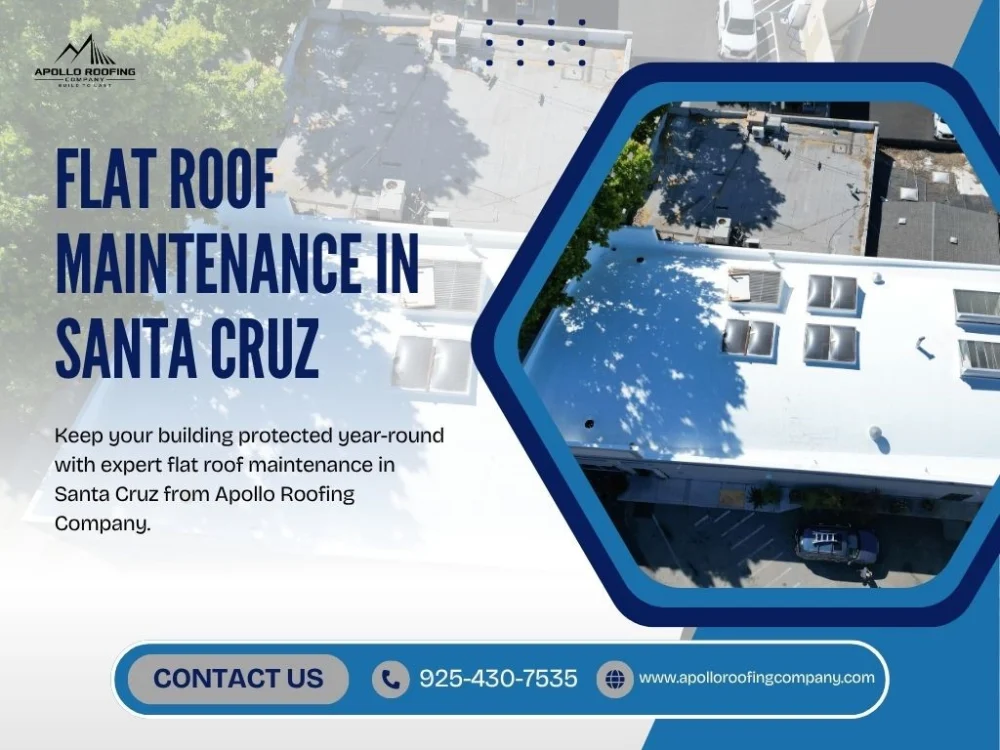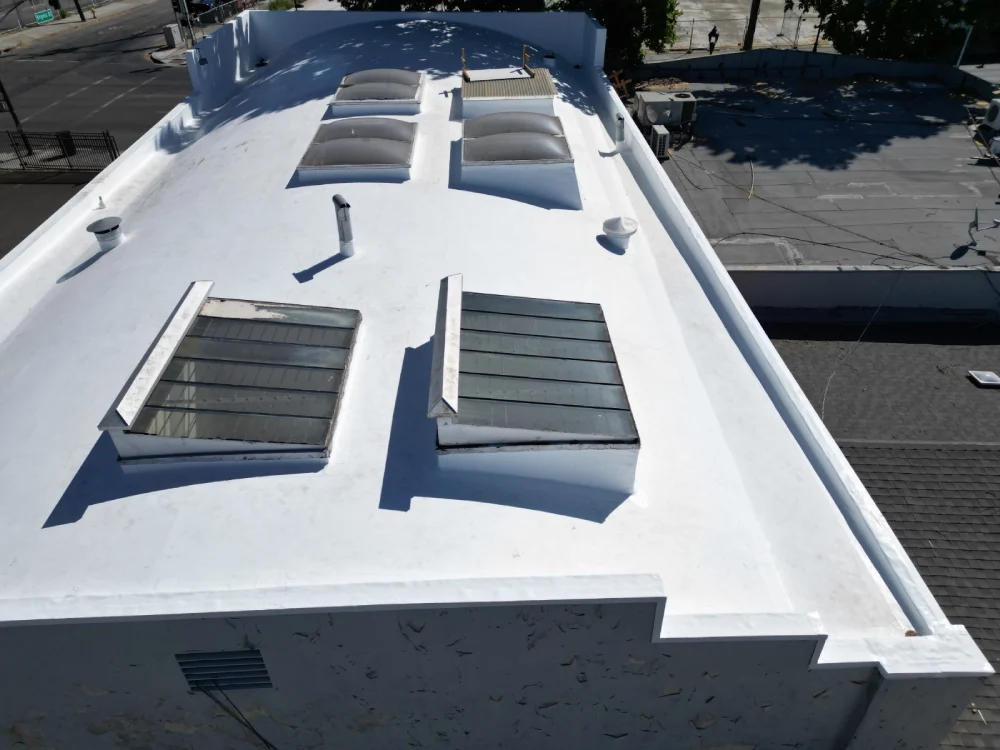Flat roofs are a popular choice across Santa Cruz for both homes and commercial buildings because they offer a modern appearance and practical use of space. Yet, the coastal climate presents unique challenges. Constant exposure to salty air, moisture, and temperature shifts can wear down roofing materials over time. To keep your roof performing well year-round, consistent flat roof maintenance in Santa Cruz is essential. Regular care helps property owners prevent costly leaks and extend the lifespan of their roofing systems.
Table of Contents
ToggleWhy Regular Flat Roof Maintenance Matters
Flat roofs require more attention than sloped ones because water doesn’t naturally run off as quickly. Without proper drainage and upkeep, small issues can quickly escalate into expensive repairs. Regular maintenance allows early detection of cracks, blisters, or drainage blockages before they cause structural problems. For coastal properties, maintenance also combats corrosion and membrane deterioration caused by sea air and UV exposure. Taking a proactive approach to seasonal flat roof care in Santa Cruz is one of the best ways to preserve your investment and prevent disruptions from roof leaks.
Seasonal Challenges Unique to Santa Cruz Roofs
Santa Cruz experiences mild temperatures but high humidity and frequent coastal fog, which can keep roofs damp for longer periods. Add in the occasional heavy rain and wind, and you have a combination that can lead to moisture intrusion or material fatigue if left unchecked. During the drier months, UV rays can weaken coatings and seams. Understanding these local conditions helps property owners plan preventive maintenance that aligns with seasonal changes and keeps roofs strong through every shift in weather.
Step One: Inspect for Visible Damage and Ponding Water
A thorough visual inspection is the foundation of good maintenance. Walk the roof surface and look for soft spots, blistering, cracks, or areas where water tends to pool. Ponding water is one of the most common signs that drainage systems need attention. Even shallow puddles can accelerate wear on roof membranes and coatings. Regular inspections after storms or windy days help ensure small problems are caught before they worsen.
Step Two: Clear Debris and Keep Drains Flowing
Leaves, branches, and coastal debris can accumulate quickly on flat surfaces, especially during fall or after high winds. When drains or gutters are blocked, water can back up and seep into vulnerable areas. Keeping the roof surface clean is one of the simplest yet most effective ways to prevent leaks. Monthly cleaning or professional debris removal is especially important for buildings surrounded by trees or near the ocean where debris is frequent.
Step Three: Check Seams, Flashing, and Roof Edges for Early Wear
Seams and flashing are often the first places where leaks begin. Over time, exposure to heat and salt air can cause seals to loosen or crack. Inspecting the perimeter edges and transitions around vents, skylights, or HVAC units ensures that water cannot infiltrate. If you spot loose materials or signs of corrosion, it’s best to call a roofing specialist for repairs before the next rain arrives.
Step Four: Examine Roof Coatings and Surface Protection
Roof coatings act as a shield against UV rays, moisture, and chemical exposure. In coastal areas like Santa Cruz, coatings degrade faster due to constant humidity and salt in the air. A dull or cracked surface may signal that your roof coating needs to be refreshed. Reapplying protective coatings not only enhances waterproofing but also improves energy efficiency by reflecting sunlight and keeping interior spaces cooler.
Step Five: Schedule Professional Inspections Twice a Year
Even the most attentive property owner can overlook subtle warning signs. That’s why scheduling professional inspections twice a year is a smart routine. Roofing experts can identify hidden weaknesses, test drainage systems, and ensure that all flashing and seals are secure. These checkups are best timed before the rainy season and again in early spring. Partnering with a trusted local roofer ensures consistent quality and peace of mind throughout the year.
Preventive Maintenance Tips for Commercial Flat Roofs
Commercial buildings often have larger flat surfaces and heavier rooftop equipment, which means more stress on roofing systems. Preventive maintenance for these properties should include checking load-bearing areas, inspecting around HVAC curbs, and maintaining walkway pads to prevent punctures. Businesses that invest in regular upkeep avoid costly disruptions, interior leaks, and energy loss caused by hidden damage. Reliable flat roof maintenance in Santa Cruz can be the difference between a long-lasting roof and one that fails prematurely.
Sustainable Care Practices for Long-Lasting Flat Roofs
Sustainability and roofing longevity go hand in hand. Keeping a flat roof in good condition reduces material waste and extends its service life. Using reflective or cool roof coatings helps maintain energy efficiency and reduces heat absorption. For eco-conscious property owners, integrating green roof elements or solar panels can further improve performance. Consistent, eco-friendly maintenance contributes to a healthier environment and a stronger, longer-lasting roof system.
When to Repair vs. Replace a Flat Roof
Knowing when it’s time to repair or replace your flat roof is crucial. Small punctures or seam separations can often be repaired quickly, but widespread cracking or ponding that persists after repairs may signal deeper structural issues. If your roof is nearing the end of its lifespan or repairs have become frequent, a professional evaluation can help determine the most cost-effective solution. A full replacement may provide better long-term value and improved energy performance.
Protecting Your Investment With Professional Care
Your roof protects everything beneath it, from equipment to employees and family members. Partnering with a professional roofing company ensures that maintenance is done correctly and safely. Experts have the tools and training to detect potential leaks, apply coatings properly, and ensure all systems are functioning efficiently. With regular professional care, property owners can extend the lifespan of their roofs and protect their properties against the unpredictable coastal climate.
FAQs About Flat Roof Maintenance in Santa Cruz
How often should I inspect my flat roof in Santa Cruz?
It’s recommended to inspect your roof at least twice a year, ideally before and after the rainy season, and after any severe weather event.
What are the most common flat roof problems in coastal areas?
Ponding water, membrane blistering, and corrosion from salt air are common issues that require consistent attention.
Can I perform flat roof maintenance myself?
Basic cleaning and debris removal are safe for most property owners, but detailed inspections and repairs should be handled by professionals to ensure long-term protection.
How does salt air affect flat roofing materials?
Salt accelerates corrosion and breakdown of coatings and metal components, especially if regular cleaning and protective treatments are not maintained.
What’s the best time of year to schedule flat roof maintenance in Santa Cruz?
Early fall is ideal to prepare for the rainy season, while spring inspections help identify any damage caused by winter moisture.
How long can a well-maintained flat roof last?
With regular seasonal flat roof care in Santa Cruz, most flat roofs can last 20 to 30 years, depending on materials and maintenance frequency.
Count on Apollo Roofing Company for Dependable Flat Roof Maintenance in Santa Cruz
A well-maintained flat roof is one of the smartest investments a property owner can make. At Apollo Roofing Company, we provide complete flat roof maintenance in Santa Cruz to help you prevent leaks, extend the lifespan of your roofing system, and keep your property safe through every season. From inspections and coatings to repairs and replacements, our team delivers reliable, high-quality service backed by experience and care. Schedule your flat roof maintenance today and make sure your roof is ready for whatever the coastal weather brings.



